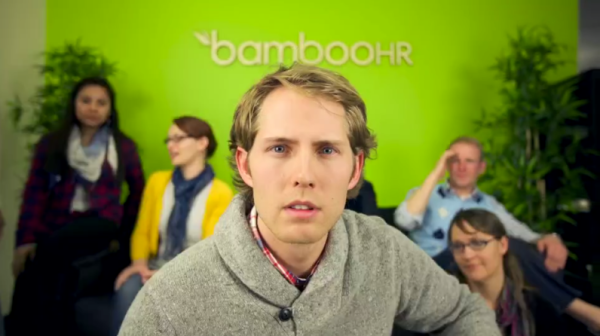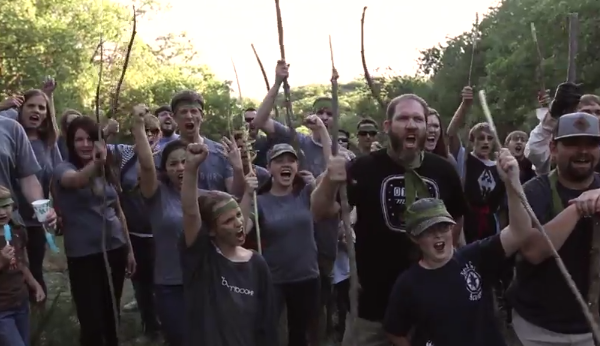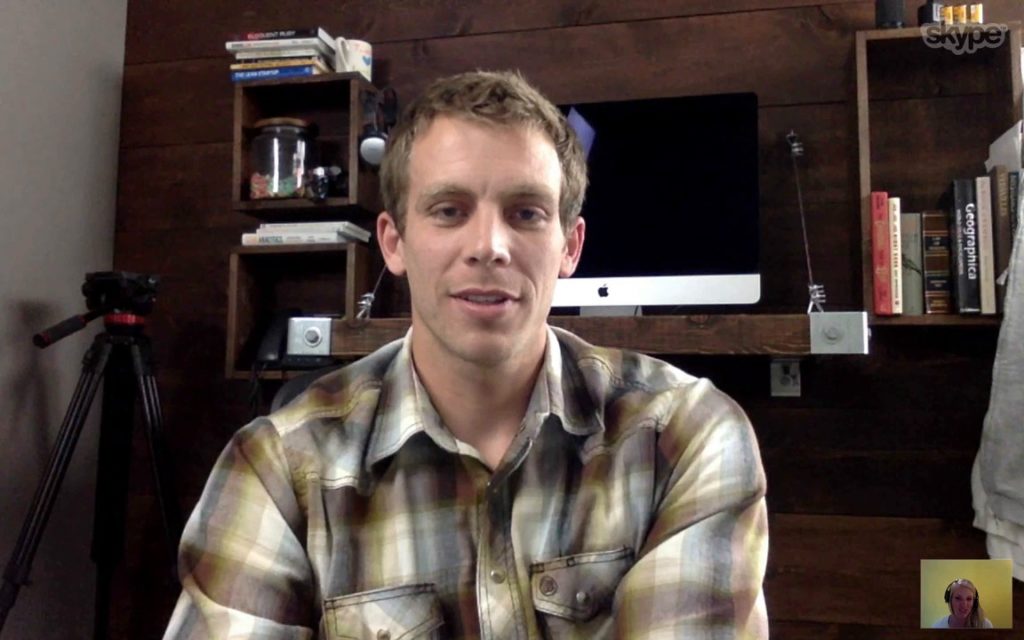We here at Demo Duck recently came across some online videos that were simply delightful. The kind of videos where you get sucked in and you can’t help but smile while watching them. We soon realized that they were being created by an HR software company.
An HR software company? Yup. We recently discovered that the friendly folks of BambooHR are using video in some awesome ways.
Because of their creativity and success at creating engaging videos, we decided to reach out to BambooHR to find out what they’re all about. If you want to check out some of their sweet vids for yourself, or maybe are in need of some excellent HR software, then be sure to take a look at their website to learn more.
Now check out our chat with Bamboo’s very own, Brenton Williamson.
What is BambooHR and what do you do?
BambooHR is data management software for Human Resources departments. We provide a much better experience than what most small and medium businesses are facing in HR. Most of them use paper files or spreadsheets to keep track of all of their employee data. We give them a refreshing cloud-based software that helps them manage all that, helps them glean lots of great reports from all of their data, and keep track of everything.
How do you currently use online video? How does online video fit into the world of HR?
I categorize it into four different areas:
First, video has been great for brand awareness. For people who have never heard of us, or if it’s their first time seeing us, video has become a good way to get a broader reach.
The second area would be brand validation. Once people come to our site and they visit the different pages, there’s a lot of video embedded – video of our customers, video of certain features of our software. I think that there’s a certain amount of emotional connection that comes from watching a video and it’s kind of like a window into your company. We use mostly our own employees for our videos and so there’s a certain bit of validity that comes when you’re able to get that intimate feel with your video.
Next, we use video to educate prospects, people who are interested in using our software. We use it to highlight features or do sales demos.
Finally, we educate our customers with video. In our help section there are loads and loads of step by step tutorials. We just recently started a “Hints and Tips” series where we give little insights into different ways to use the software or better ways to use it.
So, that’s how we’re using video right now.
What got you started with video?
It was kind of the stars aligned or a combination of things. I went to film school and that’s how I personally got involved with video. As a film school graduate I started to rethink my life and wonder why the heck I did film and not something more practical and started cursing all the mentors in my life who told me to follow my dreams. Anyway, I was looking for other options to expand my skillset and pay the rent. I actually found BambooHR on Craigslist, a marketing internship opening, and marketing had been something that I was interested in so I applied and they hired me.
One of our co-founders, Ryan Sanders, has been one of the biggest reasons as to why we do video. He’s been a huge advocate of using video in business and he saw it as a way to stay ahead of our competition. Our competitors weren’t really using video at all and it’s just such a palatable format of content that it was just a really great way to stay ahead of our competition. Again, validate the brand, brand awareness, educate our customers and our prospects so
He’s been really supportive. Eventually, my marketing responsibilities slowly transitioned into more and more video oriented (stuff) so no probably 80% of my job is focused on our video strategy.
Were you around before your marketing strategy included video?
When I started we were still really young. We had no marketing. They were still focused on the product, I think we had about 20 employees at the time. So all our resources were going into developing an amazing project and nothing into marketing. Video was essentially free for us. I had my own personal equipment and I would just shoot some stuff in the back office – we’d throw up a white screen and a couple lights and got started that way. Slowly we’ve gotten better equipment and put more resources into it.
What benefits have you found from using online video? / What results or return have you seen since you started using video?
Lots of different benefits that come from using video. First of all, it’s a really effective way to reach large audiences. One example that I use is social media. We don’t have a huge social media presence – we don’t pump a lot of resources into social media but we do some. and when we post a video those posts outperform any other posts by far. I think after our last video we posted we got quadruple the impressions as we do our normal posts. So that’s really fun to see. We also see higher conversions when we put it on landing pages, we see higher conversions in email, open rates, click through rates. They all just kind of bump up.
But the big thing that we’ve found that we benefit from is trust in our brand. It comes back to that emotional attachment that people have when they see a video and when they see the faces that are behind the company and they see that they can make that human connection. One of the biggest areas in that is recruiting. Recruiting has been huge for us. We’ve grown a ton in the last year and one of our biggest turning points was when we released a Careers video. We made a video specifically for our careers page to highlight our culture and our values and there was phenomenal success there – more than we expected. After we posted that we got triple the traffic to our careers page. Tons and tons of applicants, everyone who came in we’d ask them “Why Bamboo? Why are you applying here?” and they’d say “We saw your video. It looks like a great place to work.” So that was a huge win for us – that trust in the brand.

How do you measure the success of a video?
It definitely depends on the video. There are some obvious analytics, like you can look at your views, you can look at your engagement, so how much of the video is being watched. You can look at audience reaction, how many times it’s been likes, how many times it’s been shared, what the comments are saying. Those are all things that are easy to measure. Depending on what platform you’re using to host your video, you’ll have different depth into those sorts of analytics. YouTube has a little bit of that, if you’re using Adwords to distribute you can see click through rates and stuff like that. We use Wistia to host all of our video. They have amazing analytics. I could spend all day in there looking at the different analytics from all of our videos.
But the biggest thing is that each video that you do should have a very specific objective. So the most important way of measuring success of a video is to measure that objective. So using the careers video as an example again, that video had a very specific objective, it was created for our careers page with the intention of getting more applicants. So, that’s what you need to be focused on when you’re tracking the success of the video. Not how many views necessarily, but is it accomplishing what you originally set out for it to accomplish. We can go in and look at the number of applicants we had before the video, we can look at the number of applicants after the video. We can look at the traffic to the site, to the careers page specifically, before the video and after. Other scenarios you can look at the conversion rates in emails or on landing pages and test that.
There are a lot of different ways but the most important thing is to focus specifically on the objective that you want the video to accomplish.
Where do you come up with ideas for your videos?
Great question. It starts with that objective. Originally it came from our CEO and or COO since we were so small we worked directly with them. Now objectives come from the marketing team, which my co-worker, Matt, and I are a part of. We identify what we want to accomplish and we determine if video is a good way to help accomplish that objective. Then once we know what we’re aiming for, Matt and I will start hitting the drawing board and we’ll dive into these crazy brainstorm sessions. Sometimes it gets a little weird, a little crazy. At first there’s no direction on ideas. You don’t use a budget restriction or any sort of restrictions. You just throw everything out on the table and it can get a little wild. They actually put us in our own little man cave back here where no one can be distracted from our crazy conversations.
We’ll talk to coworkers, we’ll get their ideas. We look at a lot of work that we admire from other companies that are doing cool things. We watch a lot of films on our down time outside of work that we draw from. We’re obsessed with brands like Old Spice and Skittles. I’ll look for styles and techniques from different filmmakers. Sometimes we’ll just listen to music. Music has a way of bringing out inspiration.
Any brainstorming tips for those companies who aren’t really sure where to start when it comes to thinking up new ideas?
My biggest advice there really comes back to identify your objective. I do a lot of persuasive writing as well and I can sit there all day and try to think of great ideas and not think of anything, but as soon as I have a thesis statement, as soon as I know what the argument is, the point I want to get across, then it’s easy. You just get into a flow and you know what your argument is and you can pull up supporting arguments and generate different ways to support those arguments. It’s the same thing with video. If you know your objective, it’s going to be a lot easier to figure out ways to present that “argument” in your video.
Know what you’re trying to say and then you can figure out ways to say it. If you don’t have a lot of experience with video or a big bank of creative ideas, just look at other stuff, look at things that you like and pull elements from that. I like this technique so maybe I’ll use it, I like the way they said this so maybe I’ll do something similar. It’s ok to kind of “copy” stuff here and there. It even gives you a place to start from so you can build on that. You’ll find that as you try to mimic other people’s work, that will help you generate your own creativity and you can build on it.

How has your video strategy evolved through the process?
At first it was kind of random and sporadic. We’d have this one off idea. I’d be working on my own stuff and the CEO would come over and be like “I have this idea for a video, what do you think about this?” And we’d think it was a great idea and go make it. Then we’d just go throw it out on the social networks and see what happened. So that was kind of the beginning strategy.
Now we actually have a roadmap for videos. Matt and I know what we have to work on for the next six months and we have ideas of what we’re going to work on beyond that. We’re really striving to make video a part of every aspect of the company – all the way from you’re talking sales terminology, top of the funnel, down through the sales process and even into the customer experience
How has video played a role in defining who you are as a company?
It’s been one of the most effective ways of communicating who we are. Like I said earlier, video is a window into your culture especially if you’re using your own employees in your video, which we have done almost exclusively up to this point. It really captures the voice that your company speaks with, the type of people that work there, the values you embrace. You can communicate all of that in just a matter of seconds rather than someone having to scour your website and read tons of copy. It’s just a great way to encapsulate all of your brand.
How do you plan to use video in the future?
Kind of a continuation of what we’re striving to do right now, except for with more resources. Up to this point we haven’t really spent a lot on video besides purchasing equipment and Matt and I’s salaries. Going forward, we’ll continue to put more resources into it as it proves to be effective. We’re learning right now how to track the effectiveness of video – hard metrics not just soft metrics. Dollar for dollar, what are we putting in and what are we getting out. We’ll continue to expand in areas like the top of the funnel, the brand awareness area. Matt and I love the idea of doing more advertisement type work. It will continue to just spider web out into everything we do. If you go to our site now you’ll see videos on the homepage, videos on the customer page, videos on the career page, just kind of everywhere. If you log into our software, and go to the help section there will be videos there. So it’s just a continuation of all that.
Any suggestions or advice for companies looking to get started using video?
Absolutely, Again I come back to the idea of being very specific with your objective. I know too many small companies that are just like “Oh we need a video” and they want this all encompassing video that they put everywhere and it’s just one video. Try and shift from that mindset and determine what your objectives are and go from there. Video can still be effective and not be super polished. I love what Wistia is doing. They have huge resources for small businesses who are just getting started in video and they have endless resources for how to do it – anywhere from no budget to bigger budget. So just dive in and get your hands dirty. I’d say just do it. Just get out there and start trying. You’ll evolve, you don’t need to have the perfect video the first time you do it. Just start getting experience and keep doing it. People love it. People love to watch video.
Thanks to Brenton Williamson and the entire BambooHR team for chatting with us. We look forward to more of your amazing videos in the future!
